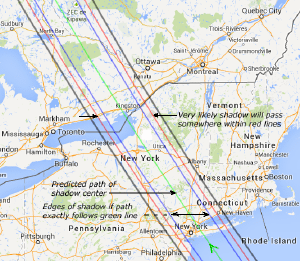Blog
In the Way
19 March 2014
 IOTA
IOTARegulus is a bright, first-magnitude star in the constellation of Leo. If you happen to live in the Northern hemisphere you can find it at night in the southwest sky. Even with a bit of light pollution it is pretty easy to observe. But if you happen to be in the central New York area, say between Syracuse and New York City, if you watch the star around 2am Thursday morning you might see the star disappear for about 10 seconds.
This temporary vanishing of Regulus has nothing to do with the star itself, but rather with an asteroid known as 163 Erigone. This 70-kilometer wide rock will pass in front of Regulus when viewed in parts of central NY, a phenomenon known as an occultation. Asteroid occultations are a pretty rare event, and when you think about it they are pretty amazing. Erigone will cast a shadow on the Earth from starlight, in much the way that the Moon casts a shadow from sunlight during a solar eclipse.
This also has research applications. Because of the relative proximity of Erigone (about 1.2 AU), people in different locations will see the occultation in slightly different ways. Some will see a longer one, some shorter. Some will see it begin and end slightly earlier than others. This information can actually be used to determine things like the shape of the asteroid.
 IOTA
IOTAThis method has been used before, and it has led to some surprises. In 2011, the asteroid 90 Antiope occulted a dim 6th magnitude star, and observers closely timed the disappearance and reappearance of the star. The plot in the figure shows the result of 50 observations from different locations, and the shape of Antiope as a binary astroid is clear. Similar observations will be made of the Regulus occultation will be made to study Eriogone.
If you happen to be near the occultation path, and would like to observe this rare event, and perhaps even contribute an observation of your own, you can find out more information at the International Occultation Timing Association website. They have information on where and when to look, and there’s even an app for that.